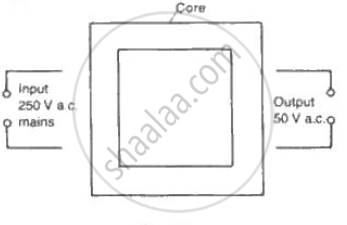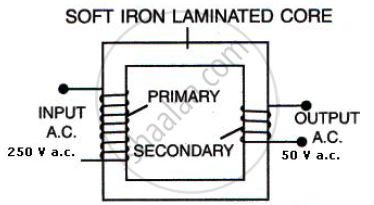Advertisements
Advertisements
Question
Fig . shows the core of a transformer and i ts input and output connections

State the material used for the core and describe th e structure of the core.
(a) Use the values given in the diagram to calculate the turns ratio for the transformer and connections, labeling all parts of the diagram .
(b) If a current of 2 A is taken from th e output, calculate th e current in the input circuit (Assume the transformer to be ideal ).
Solution
(a) Soft iron is used as the material for the core of transformer.
Structure of core: The core is made by taking thin rectangular sheets or laminas of soft iron (or silicon -steel) and dipping them in an insulating paint or varnish . These insulated sheets are stacked together to form a solid looking rectangular frame. This is called the laminated core of the transformer.
(b) Given, Ep = 250 V, E. =50 V
We know that for transformer turn ratio =
Thus, it is a step-down transformer.

Given, Is =2A
Let Ip be the current though primary.
We know that for transformer turn ratio =
Ip =
APPEARS IN
RELATED QUESTIONS
What is an electric current?
What is the conventional direction of the flow of electric current? How does it differ from the direction of flow electrons?
The figure given below shows an electric circuit in which current flows from a 6 V battery through two resistors.

(a) Are the resistors connected in series with each other or in parallel?
(b) For each resistors, state the p.d. across it.
(c) The current flowing from the battery is shared between the two resistors. Which resistor will have bigger share of the current?
(d) Calculate the effective resistance of the tow resistors.
(e) Calculate the current that flows form the battery.
How do you think the brightness of two lamps arranged in parallel compares with the brightness of two lamps arranged in series (both arrangements having one cell)?
State the S.I. unit of current.
What is meant by internal resistance of a cell?
An electrical appliance is rated at 1000 KVA, 220V. If the appliance is operated for 2 hours, calculate the energy consumed by the appliance in: (i) kWh (ii) joule.
Match the items in column-I to the items in column-II:
| Column - I | Column - II |
| (i) electric current | (a) volt |
| (ii) potential difference | (b) ohm meter |
| (iii) specific resistance | (c) watt |
| (iv) Electrical power | (d) joule |
| (v) electrical energy | (e) ampere |
